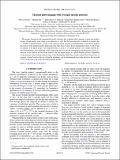Thermal ghost imaging with averaged speckle patterns
Author(s)
Shapiro, Jeffrey H.; Zerom, Petros; Shi, Zhimin; O’Sullivan, Malcolm N.; Chan, Kam Wai Clifford; Krogstad, Molly; Boyd, Robert W.; ... Show more Show less
DownloadZerom-2012-Thermal ghost imaging with averaged speckle patterns.pdf (635.0Kb)
PUBLISHER_POLICY
Publisher Policy
Article is made available in accordance with the publisher's policy and may be subject to US copyright law. Please refer to the publisher's site for terms of use.
Terms of use
Metadata
Show full item recordAbstract
We present theoretical and experimental results showing that a thermal ghost imaging system can produce images of high quality even when it uses detectors so slow that they respond only to intensity-averaged (that is, “blurred”) speckle patterns, as long as the collected signal variation is predominantly caused by the random fluctuation of the incident speckle field rather than other noise sources. In our experimental study, we show that the quality of the ghost image is not degraded when as many as 25 speckle patterns are averaged together for each measurement. This surprising result comes from the fact that the averaging of speckle patterns leads to a decrease in the contrast but not in the kurtosis, and the image quality of a ghost imaging system is dependent on the kurtosis rather than the contrast ratio of the illuminating field. These results suggest that a broad class of imaging systems based on the use of speckle techniques can be implemented even using detectors that respond slowly on the time scale of the fluctuating speckle pattern.
Date issued
2012-12Department
Massachusetts Institute of Technology. Department of Electrical Engineering and Computer Science; Massachusetts Institute of Technology. Research Laboratory of ElectronicsJournal
Physical Review A
Publisher
American Physical Society
Citation
Zerom, Petros et al. “Thermal Ghost Imaging with Averaged Speckle Patterns.” Physical Review A 86.6 (2012). © 2012 American Physical Society
Version: Final published version
ISSN
1050-2947
1094-1622